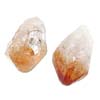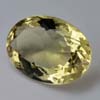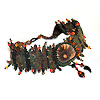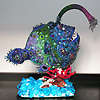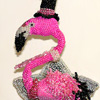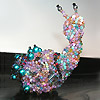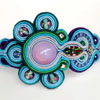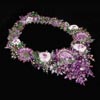November, 2008

Happy Thanksgiving!Got turkey? Make yourself comfortable and read!
Citrine or amethyst?
Contact us with any questions at
info@mylovelybeads.com.
Featured artist - Andrea Landau Estate (vintage) jewelry New Dimensions in Beadwork Soutache - new jewelry media December upcoming events Best regards,
MyLovelyBeads.com Team |
Citrine or amethyst?Citrine is a transparent, coarse-grained variety of the mineral quartz. It is a semiprecious gem that is valued for its yellow to brownish color and its resemblance to the rarer topaz. The name "citrine" is derived from the French word for lemon - CITRON. Citrine is actually somewhat rare in nature, most citrines on the market have been heat treated. Specimens of low grade, inexpensive amethyst or smoky quartz are often cooked at high temperatures to produce the more profitable orange yellow citrine. Citrines whose colors have been produced by artificial means tend to have much more of an orange or reddish caste than those found in nature, which are usually a pale yellow. Unfortunately for citrine it is itself often confused with the more expensive orange-yellow topaz and is at times sold as topaz by unscrupulous dealers. This practice has soured many potential citrine fanciers who see citrine as a fake topaz and not as a legitimate gemstone. Natural citrine is often used in rings or pendants; less attractive gemstones are often made into necklaces. Citrine can naturally form together with amethyst making a bi-colored gemstone known as ametrine. Ametrine can be also made by heating an amethyst until it turns into citrine, then irradiating a part of the resulting crystal or gemstone to convert that portion back to amethyst. If left in sunlight for many hours a citrine will permanently change its coloring. Ancient cultures believed that placing a Citrine Gemstone on the forehead of an elder would increase his psychic power. This lovely yellow jewel is also known as the lucky merchants stone and if placed in the cash drawer it will help the money flow by increasing sales. Citrine is often given as a symbol of hope, youth, health and fidelity. Soldiers in Caesar's legions are said to have worn Citrine on the chest during battle making use of the Gemstones life-saving properties. Natural citrine is not common and occurs sparingly in many large quartz deposits. Most material comes from Minas Gerais, the state of Rio Grande do Sul, Brazil, but almost all of the Brazilian material is heat-treated amethyst. Natural deposits of citrine are also found in Argentina, Brazil, Madagascar, Myanmar, Namibia, Scotland, Spain, in the Ural Mountains of Russia, and in Dauphine, France. California within the United States is another good source. Citrine is a November birthstone, you could read about another November gem, amber, in our last year's November issue. |
|
Featured artist
Born in Brazil, moved to the United States at the age of three with her family, and have been living since 1986 in the medieval center of a beautiful city, located at what could be described as the border between Northern and Central Italy, Andrea Landau is an extremely talented bead artist. Andrea had the incredible fortune of being able to travel extensively ever since she was a small child, and have always been fascinated by faraway lands exotic cultures. Her parents transmitted to her their love for art and culture, and she is grateful to them for encouraging her to enrich herself through art and beauty. Andrea says, "Beading is my most recent discovery and the one I've dedicated the most energy to, out of all of the various mediums with which I've experimented. I've always been very absorbed by all forms of arts and crafts ever since I could pick up a crayon, and have dabbled in many. My love for art and creativity drove me to choose an art major, among others, in college. The bulk of my artistic experience throughout my life has been in smithing, drawing and painting, along with various fiber arts such as macrame, knitting, textile loom-weaving, etc, all of which have accompanied me over the years, until I discovered the beading obsession which absorbs all of my free time. I started playing with beads almost 4 years ago, and beading seriously a little over three years ago. I firmly believe that first discovering and later focusing on beading is one of the best things I've ever done for myself, both as a person and as an artist. I'm a self-taught beader, still self-teaching. The intro is the basics, but without inspiration the basics wouldn't have existed, so a few words on inspiration. Inspiration is everywhere, inside and outside of us. Inspiration is so easy and accessible, yet sometimes so elusive.I find inspiration in everything, from the words going around in my head to a drop of water, from nature to trash, from situations to architecture, from a painting or sculpture to an endless poem. A pretty flower by the road can catch my eye, but if I take a close-up photo in macro mode of a detail of that pretty flower, I'll find myself catapulted into a tumult of design ideas. Feeling uninspired at some point afflicts us all, myself included. Learning to look at things differently, to perceive detail in what could be a relatively uninteresting source at first glance... opens new worlds..."
The full article by Andrea Landau
|
|
Estate (vintage) jewelry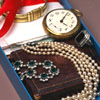
Jewelry which is termed "estate" or "vintage" includes many decades or eras, that include Georgian, Early Victorian, Mid-Victorian, Late Victorian, Arts and Crafts era, Art Nouveau, Edwardian, Art Deco and Retro. Vintage jewelry can range from inexpensive to highly costly, but the act of collecting such jewelry is enjoyable for enthusiasts. Georgian jewelry (1714-1837) Georgian era jewelry is handmade, making the quality of each piece variable. Needless to say, Georgian jewelry is very rare. Often featuring nature-inspired designs such as leaves and birds, Georgian jewelry frequently includes precious stones. Early Victorian, romantic jewelry (1837-1850) Like jewelry of the Georgian era, early Victorian era jewelry features nature-inspired designs. Frequently, these designs would be delicately and intricately etched into gold. Lockets and brooches were popular everyday jewelry during the early Victorian era whereas colored gemstones and diamonds were worn during the evening. Mid-Victorian, grand jewelry (1860-1880) Because the Grand or Mid-Victorian era corresponded with the width="500" height="600" Victoria's husband, many jewelry pieces have solemn, grave designs. Known as mourning jewelry, the pieces feature heavy, dark stones. Jet, onyx, amethyst, and garnet are frequently found in jewelry from this period. The jewelry also became especially creative during this period. More colorful designs were born featuring shells, mosaics and colorful gemstones. Late Victorian, aesthetic jewelry (1885-1900) During the Late Victorian or Aesthetic period, jewelers used diamonds and feminine, bright gemstones such as sapphire, peridot, and spinel. Star and crescent designs as well as elaborate hat pins were also popular. Arts and crafts jewelry (1894-1923) Due to the Industrial Revolution, many jewelry designers rebelled during the Arts and Crafts movement, returning to intricate jewelry designs and handmade craftsmanship. It was common for jewelry of this era to be simple in pattern, made of colorful, uncut stones. Art Nouveau jewelry (1895-1915) Designed by Rene Jules Lalique in France and other jewelers in America, Art Nouveau jewelry features natural designs such as flowers and butterflies. Edwardian jewelry (1901-1910) The Edwardian period was born when Queen Victoria died and her son Edward became king. During this period, expensive gemstones such as diamonds, emeralds and rubies and elaborate designs were the fashion. Art Deco jewelry (1920-1935) Influenced by African, Egyptian and Japanese themes, Art Deco jewelry is famous for its geometric designs, sharp lines, and bright colors. Bakelite, celluloid, enamel and doublets were used frequently during this era. Necklaces were long and bracelets were worn many at a time. Amber and murano beads were worn as well as chokers. Retro jewelry (1940s) Inspired by Hollywood, Retro jewelry is colorful, bold and elaborate. Commonly worn were large cocktail rings, bracelets, watches, necklaces and charm bracelets. |
|
New Dimensions in Beadwork. Part 1Today Andrea Landau shares with us her thoughts of beadwoven and bead embroidered sculptures, of the creative process - how to make beaded sculptures. Thank you, dear Andrea! A lot of people, not only bead designers, will find your article very interesting and useful. Introduction. Beadwoven Sculpture Vs. Bead Embroidered Sculpture Sculptures made with beadweaving or bead embroidery techniques are about the most spectacular example of pushing the limits in beading. While jewelry made with seed beads is highly subjective - it either appeals or it doesn't - I have yet to see anybody, beader or non-beader, remain impassible when viewing beadwork in sculptural form. It's simply amazing, no holds barred. In the next couple issues of the My Lovely Beads newsletter I will try to provide basic knowledge and tips needed to consider, approach, plan and execute a substantial and entirely dimensional bead sculpture, regardless of the subject matter which might be eventually selected for execution. We'll be exploring sculptural work with bead embroidery techniques. Before getting to the nitty gritty, I'd like to spend a few words to discuss sculptural work with beadweaving techniques. Between beadwoven sculptural work and bead embroidered sculptural work, beadweaving is probably the more easily approachable of the two. This is mostly because it does not require the somewhat advanced notions involved in planning, engineering, troubleshooting and assembly required to effectively execute a bead embroidered sculptural piece. Any intermediate beader with a good knowledge of possible variations, increasing and decreasing in the stitch of choice already has all of the skills necessary to make a sculpture with beadweaving. The only other skills required are necessary for both beadwoven and embroidered sculptures and have nothing to do with beads, but with the artist's ability to make their sculpture resemble the original idea. If making an abstract sculpture, the only limits are those imposed by the artist. If on the other hand the idea is to produce a lifelike replica of something, the artist will need to have some basic skills in sculpture and or drawing... a good rule of thumb is that if you can sketch something lifelike from more than one angle without having to trace, then you can produce a lifelike beadwoven sculpture. Those who don't have drawing skills can opt for a stylized bead sculpture, which affords more room for personal artistic expression. The full article "New Dimensions in Beadwork - An Overview of Bead Sculpture. Part 1" |
|
Soutache - new jewelry media
Born and grown up in Moscow, Russia, and graduated from Moscow State University as a Master of Psychology, Anneta Valious has been living with her children and her husband in France for ten years. As Anneta says, she has been sewing and doing other crafts since she was a child, and she took those skills after her grandmother and her mother. In 2006, when looking for a gift for their daughter, Anneta and her husband bought a kid's beading kit. They took an active interest in beading and made research: what else can be made using beads except simple bracelets and necklaces? So, thanks to her husband, Anneta started beading! Anneta has learned gems, beads, other materials, basic techniques, and once she decided to try her own jewelry designs. She wears gemstone jewelry since her youth, likes gems of any kind, and uses them now in her jewelry. In the early 2008 Anneta found a website of a French jewelry designer Dori Csengeri. She was so excited and impressed, that in a while she tried a new media in jewelry - soutache, used in Dori 's designs. Anneta knew from her mother, who used soutache in macrame, that it is a narrow flat decorative braid, a type of galloon, but could never imagine before soutache in jewelry making. Anneta discovered that soutache allows to create not only straight lines, but also complicated curves; beads of any color and size can be used in such type of jewelry. Anneta started experimenting and got success! She says, that she is happy creating jewelry using soutache and beads. We believe you will enjoy her jewelry as much as we do!
Soutache jewelry by Anneta Valious
|
|
Upcoming events
November - December, 2008 The exhibit features pieces made by the winning artists from the Bead Museum's 1st Annual International Juried Jewelry Design Competition Celebrating Beads, the journey of... Pictures from the Celebrating Beads, the journey of... Exhibition |
|
NoteIf you don't see the newsletter properly formatted please click here: November Issue |
© 2010 MyLovelyBeads.com All Rights Reserved.
If you do not want receive our newsletter and you wish to remove your email address from our mailing list, please click the following link to unsubscribe.



